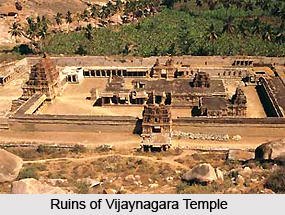 Bukka Raya I belonged to the Sangama Dynasty and reigned over the empire of Vijayanagara. Nachana Soma, the Telugu poet was patronised by this ancient ruler. The accounts of the earlier portion of the lives of Bukka and Raya, his brother are shrouded in mystery and there are many legends associated to these people. Hakka was also referred to as Harihara I.
Bukka Raya I belonged to the Sangama Dynasty and reigned over the empire of Vijayanagara. Nachana Soma, the Telugu poet was patronised by this ancient ruler. The accounts of the earlier portion of the lives of Bukka and Raya, his brother are shrouded in mystery and there are many legends associated to these people. Hakka was also referred to as Harihara I.
According to a popular belief, Hakka and Bukka had been born amongst the Kuruba clan and served as commanders in the royal army belonging to the King of Warangal. Following the defeat of the ruler of Warangal by Muhammad Bin Tughlaq, Hakka and Bukka were captured, made prisoners and transferred to Delhi. They were compelled to convert to the religion of Islam. However, Bukka and Hakka had managed to retreat, ensured that their Hindu traditions were left unscathed and established the Vijayanagara Empire, being motivated by Vidyanara, a Brahmin sage.
There is, however, historical account which asserts that Bukka and his brother Hakka were related to the Hoysala Empire and were born near the Hampi, which constitutes the present-day region of Karnataka. They were said to have been the successors of the dynasty of the Hoysalas. Bukka Raya`s 21-year rule was marked with prosperity in the kingdom and witnessed significant political expansion, as per the story of Nuniz. Bukka Raya was an efficient king and his kingdom extended to most of the areas located in Southern India. Shambhuvaraya Kingdom of Arcot, as well as the Reddy clans of the region of Kondavidu had lost their kingdoms to Bukka Raya around 1360. He followed a powerful policy of political annexations and had conquered the area which was near Penukonda. In the year 1371, the Sultan of Madurai was defeated by Bukka and therefore his kingdom, which extended till Rameswaram was also included in the empire of Bukka. `Madhuravijayam`, which was a major Sanskrit work composed by Gangambika, the wife of Bukka had recorded the campaign of Bukka and his son Kumara Kamappa.
Bukka assumed governance over Goa, the land of Orissa, the Jaffna kingdom of Ceylon, `zamindars` of the region of Malabar and also the Bahmanis for gaining authority over the area of Tungabhadra - Krishna- Doab. The rulers of these regions were forced to pay rich tributes to Bukka. However, Bukka entered into frequent conflicts with the Bahmani Sultans. The rule of Mohammed Shah I and Mujahid saw such clashes. Another legend is of the view that Bukka had sent a mission to the country of China. Bukka died in 1380 and Harihara II succeeded to the throne after Bukka`s death. Under the regime of Bukka, the capital was shifted from Anegondi to the Vijayanagara Empire. Despite the numerous battles and internal conflicts within the empire, Bukka was capable of introducing some vital improvements for his city. Literature flourished under his rule. Sayana and Vidyanara were the guides of several gifted scholars who existed during the period of Bukka Raya I. The renowned commentary written by Sayana about Aranyakas, Brahmanas and Vedas were all performed during that time.



















